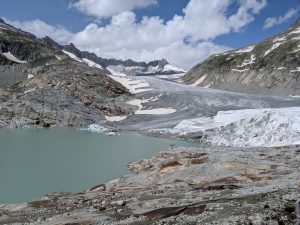Understanding how glaciers melt is key to understanding environmental change, water security, and sea level rise. Traditional methods to measure glacier melt, such as weather data and poles to measure snow depth and melt, have limitations. They are labor-intensive, difficult to use over large areas, and lack the high spatial and temporal resolution needed for comprehensive long-term studies.

Recently, a new tool called Distributed Acoustic Sensing (DAS) has gained interest. DAS uses fiber-optic cables to capture sound waves traveling through the ground. Fiber-optic cables are more durable and easier to deploy than traditional instruments like seismometers, making DAS an efficient tool for studying glaciers.
A recent study in the Journal of Glaciology, led by ESS graduate student John-Morgan Manos, used DAS to train a machine learning model to predict glacier runoff. During the 2020 melt season, researchers used DAS to monitor glacier runoff from Rhonegletscher, a temperate mountain glacier in the central Swiss Alps. They deployed a 9-kilometer fiber optic cable across different parts of the glacier, including both the accumulation zone (where snow builds up) and the ablation zone (where it melts away).
The researchers found that the sound waves detected by the fiber optic cable are potentially linked to water flowing from the glacier, known as proglacial discharge. A stream gauge located downstream from the glacier recorded the proglacial discharge. They compared their DAS-trained machine learning model to other models that use weather data or temperature-based calculations and found that the DAS model performed better in predicting glacier runoff. Further analysis showed that high-frequency sounds from the turbulent flow of water on the glacier’s surface were key to improving the accuracy of predictions. The study also shows that there is significant spatial variability to the sensitivity of glacier runoff prediction.
This study shows that DAS-trained machine learning models are a promising new method for inferring glacier runoff at high spatial and temporal resolutions. With further testing, this technology could be used to monitor other glaciers and help estimate water discharge more quickly and accurately.
Learn more about this work in the video below.